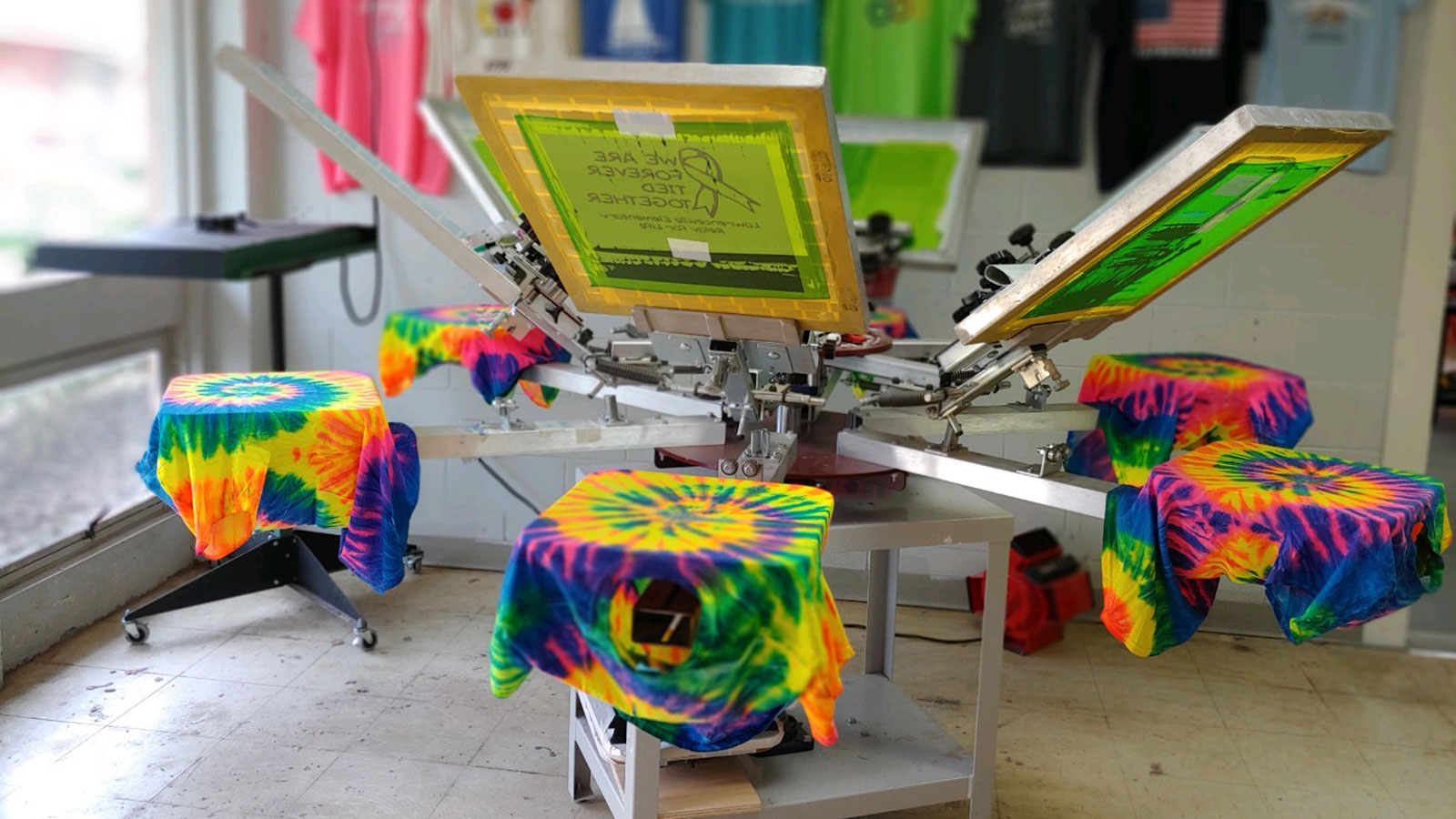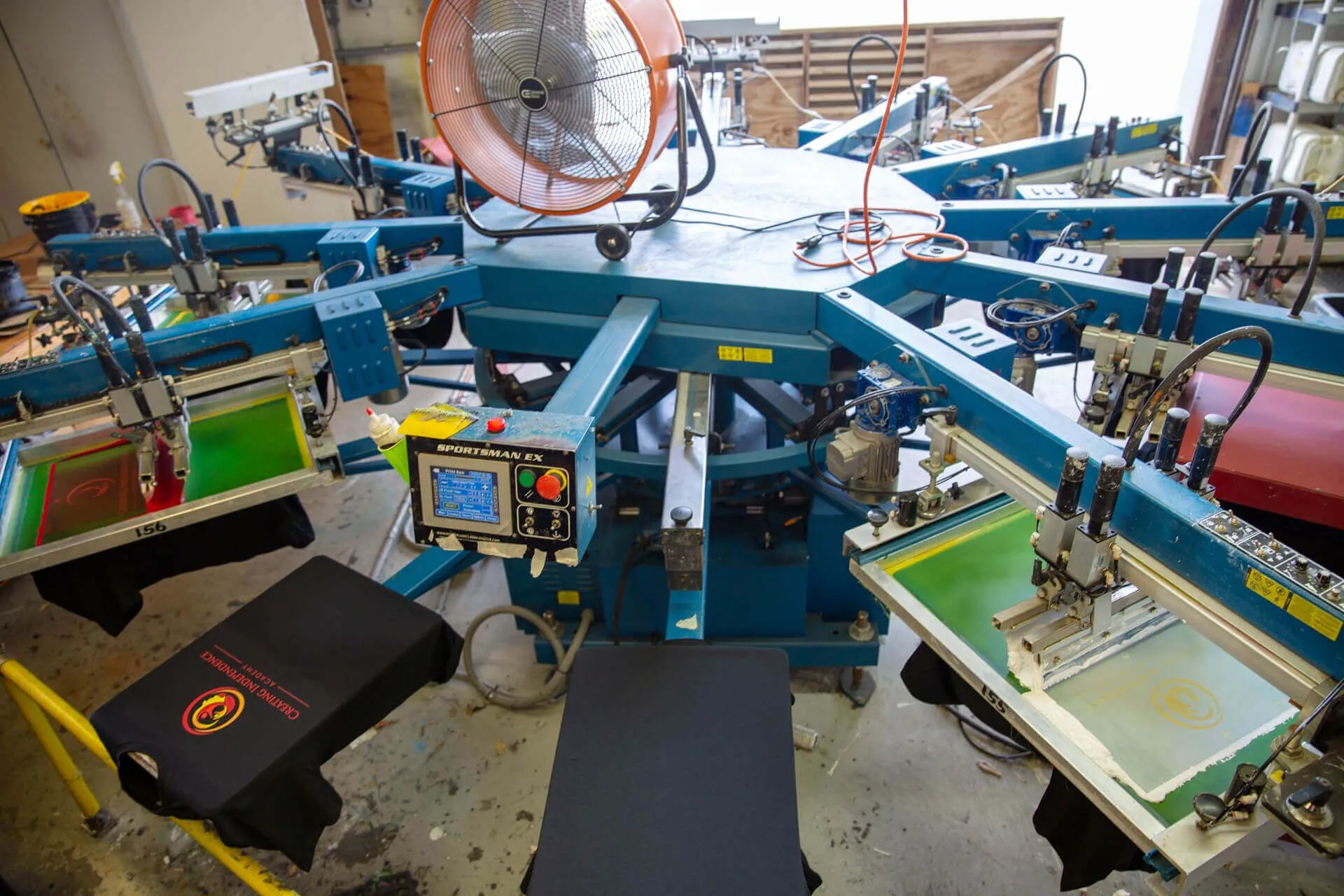Fast Turnaround Custom Screen Printing for Events
Wiki Article
Display Printing Uncovered: Everything You Need to Learn About Tee and Garment Printing Strategies
If you've ever wondered just how those dynamic styles end up on your preferred t-shirts, you remain in the right place. Display printing is a fascinating technique that combines art with strategy, using unlimited opportunities for creative thinking. Recognizing the basics, from equipment to ink selections, can significantly affect your results. Prepared to explore the vital components that make display publishing an art form? Let's discover the information that can raise your tasks.
The Basics of Screen Printing: Exactly How It Works
When you plunge right into screen printing, you'll discover it's both an art and a scientific research. At its core, display printing involves developing a pattern, or screen, that enables ink to pass via only in particular areas.Setting the display over the textile, then utilize a squeegee to press ink via the screen onto the garment. Each step is important, and understanding them will certainly raise your screen printing skills, changing straightforward garments right into unique, meaningful pieces.
Sorts Of Screen Printing Techniques
Once you understand the basics of display printing, it's time to discover the numerous methods that can elevate your styles. One preferred method is conventional display printing, where ink is pressed via a stenciled display. This strategy is terrific for bold, vivid shades. There's water-based ink printing, which provides a softer feel and is eco-friendly, yet it calls for a different technique to treating.If you're aiming for great details, consider discharge printing. This strategy removes color from the textile, leaving a soft, vintage look. One more alternative is plastisol printing, known for its sturdiness and vibrant colors, making it a favorite for numerous brands. Lastly, explore halftone printing to create gradient effects and intricate designs. Each strategy has its unique charm, so do not wait to try them bent on locate what matches your design best!
Crucial Devices for Display Printing
To attain spectacular outcomes in screen printing, having the right equipment is essential. You'll need a tough display printing frame, which holds the mesh that moves your style onto the garment. Next off, purchase top notch mops; these are crucial for using ink evenly across the screen. You'll additionally require a great exposure system to develop your displays, in addition to a washout cubicle for cleaning them after use. A trustworthy warmth resource, like a conveyor dryer or warm press, is vital for curing your prints to ensure long life. Don't forget a correct office, geared up with tables and storage space for your materials. Protective gear, such as gloves and masks, will certainly maintain you secure from chemicals and inks. With the right tools, you'll be well on your way to generating professional-quality prints.Selecting the Right Inks and Products
When selecting inks and materials for screen printing, you require to think about the sort of ink that functions finest for your job. Think of textile compatibility to ensure your styles look last and terrific long. Also, discover environment-friendly ink choices to make your printing process much more sustainable.Kinds of Display Inks
Picking the best display ink is important for attaining vibrant, durable prints that fulfill your task's needs. There are a number of types of display inks to analyze. Specialty inks, such as metallic or glow-in-the-dark, can include distinct effects to your layouts.
Textile Compatibility Considerations
Understanding textile compatibility is essential for achieving high-grade screen prints, particularly because different materials respond distinctly to numerous inks. When selecting inks, consider the textile type-- cotton, polyester, or blends. For cotton, water-based inks work well, using softness and breathability. Polyester, on the other hand, typically calls for plastisol inks for far better bond and vibrant colors. If you're publishing on blends, you could need to make use of a mix of both kinds. Always check your inks on example fabric to assure they stick properly and maintain color stability. In addition, maintain in mind that textile weight and structure can affect the last result, so picking the appropriate ink and product combination is essential for your task's success.Eco-Friendly Ink Options
Eco-friendly inks are coming to be a preferred option for screen printers that intend to reduce their ecological effect while keeping high quality. When choosing inks, think about water-based inks, which are less unsafe and much easier to tidy up contrasted to conventional solvents. These inks bond well with materials, delivering vivid outcomes without hazardous chemicals. You may likewise discover eco-solvent inks that use less unpredictable organic compounds (VOCs), making them a safer alternative for both your health and wellness and the earth.In addition, try to find inks made from sustainable resources, such as soy or vegetable-based alternatives. By choosing the best inks and materials, you'll not just produce magnificent layouts however likewise contribute to a more lasting printing procedure. Make the switch, and your prints will certainly reflect your dedication to the environment!
Preparing Your Style for Display Printing

Submit Style Requirements
To guarantee your design looks dynamic and sharp on textile, you'll need to pay close interest to file format needs for display printing. Make certain your layout has a transparent history to avoid unwanted white sides on your prints. Maintain color settings in mind; CMYK is basic for screen printing, so transform your RGB develops accordingly.Shade Splitting Up Strategies
Shade separation is a necessary action in preparing your style for screen printing, and mastering it can considerably boost your print top quality. You'll need to damage your layout right into specific shades, as each shade calls for a different screen throughout printing. Beginning by determining all the shades in your design and develop layers each. You can use software like Adobe Photoshop or Illustrator to isolate and different colors successfully. Be certain to conserve each layer as a separate file, generally in a layout like TIFF or PSD. This precision not only guarantees exact shade representation but additionally streamlines the printing procedure. By paying focus to shade splitting up, you'll achieve expert and lively outcomes in your screen-printed garments.Resolution and Size
Achieving the most effective outcomes in screen printing begins with assuring your design has the appropriate resolution and dimension. Ideally, your artwork must be at least 300 DPI (dots per inch) for sharp, clear prints. Your final item might look amateur and pixelated. if you make use of reduced resolution.When it involves t-shirt printing dimension, consider the dimensions of your print location. Design your art work to match the final print dimension, preferably developing it in the real dimensions you'll be printing. In this manner, you'll stay clear of any unforeseen scaling concerns.
Constantly inspect your layout in both vector and raster styles. Vector graphics can be scaled without shedding top quality, making them excellent for screen printing. Preparing properly will assure your style looks fantastic on every garment!
Step-by-Step Screen Printing Process
Screen printing is a vibrant procedure that allows you to produce vibrant styles on different surfaces. To get started, you'll need a display, solution, and your chosen ink.After washing out the unexposed solution, your screen is all set. Set it up on your printing surface and straighten your garment under it. Put ink onto the screen and use a squeegee to press the ink via the pattern onto the material. Lift the display meticulously and allow the print completely dry. Cure the ink utilizing heat to guarantee longevity. That's it! You have actually effectively display printed your design.
Tips for Effective Display Printing Projects
While you're diving into your screen printing jobs, keep in mind that preparation is key to success. Beginning by gathering all your materials-- inks, garments, squeegees, and displays. A tidy work space helps protect against unwanted errors, so clean prior to you start.Following, verify your art work is high-resolution and properly sized for your garment. Examine your display for correct direct exposure and clean it completely to prevent smudges. When mixing your inks, comply with the producer's guidelines to accomplish the best consistency.
Throughout printing, use even stress with your squeegee for constant results. Don't hurry; take your time to verify each print meets your requirements. After printing, allow your garments completely dry completely before taking care of or packaging them.
Last but not least, constantly keep a sample of your help future recommendation. This method, you can assess your progress and improve your techniques in time. Satisfied printing!

Regularly Asked Questions
How much time Does It Require To Set up a Display Printing Task?
Establishing up a screen printing job usually takes around thirty minutes to an hour. You'll prepare the screens, mix inks, and readjust the press. The moment differs based upon intricacy and experience, so stay arranged!Can I Publish on Different Textile Types Utilizing the Very Same Strategy?
Yes, you can publish on various fabric types using the exact same method, but you'll need to change your inks and setups. Some materials soak up ink differently, so experimenting guarantees the very best outcomes for every material.What Prevail Blunders to Stay Clear Of in Display Printing?
When screen printing, stay clear of usual mistakes like using the wrong ink, overlooking proper direct exposure times, or missing pre-press checks. Constantly evaluate your setup and keep clean screens to guarantee quality results each time.Just How Can I Correctly Clean and Keep My Screen Printing Devices?
To correctly tidy and preserve your display printing equipment, you ought to regularly clean screens with suitable solvents, inspect mops for wear, and ensure all tools are saved dry and dust-free. Uniformity prevents pricey repair services and improves performance.Is Display Printing Eco-friendly Compared to Various Other Methods?
Screen printing can be a lot more environmentally pleasant than various other approaches, specifically if you utilize water-based inks and eco-conscious materials. By picking sustainable products and practices, you decrease waste and lessen your influence on the earth.Screen Printing Uncovered: Every Little Thing You Need to Know Regarding Tee and Garment Printing Methods
At its core, display printing involves producing a pattern, or screen, that enables ink to pass through only in details areas. Placement the screen over the textile, then use a squeegee to press ink with the screen onto the garment. One prominent technique is conventional screen printing, where ink is pushed via a stenciled display.When choosing inks and materials for screen printing, you need to take into account the kind of ink that functions finest for your task.
Report this wiki page